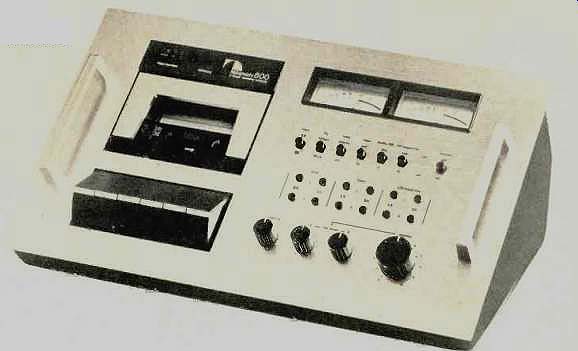
MANUFACTURER'S SPECIFICATIONS:
Frequency Response: 40 Hz to 18 kHz.
Harmonic Distortion: Less than 1.5% for 400 Hz at 0 VU; less than 0.5 % with IM Suppressor in.
Signal/Noise Ratio: 60 dB with SX tape and Dolby at 0 VU, 68 dB at 3 1/4 THD with IM Suppressor.
Separation: 35 dB. Crosstalk: 60 dB.
Erasure: 60 dB. Input Sensitivity: 60 mV at 50K ohms.
Output Level: 580 mV.
Wow and Flutter: 0.12% WTD peak.
Speed Deviation: ±10/0.
Dimensions: 15-3/4 in. (40 cm) W by 6-7/8 in.
(17.5 cm) H by 9-3/8 in. (23.8 cm) D.
Weight: 14.3 lbs. (6.5 kg).
Suggested Retail Price: $500.00.
The 600 Cassette Console is one of a group of special new Nakamichi components, the Recording Director Series. The front panel is solid aluminum, over 1/8-in. thick, inclined back about 30 degrees. This position is excellent for on-table control and monitoring. The cassette well is on the left side, with the counter and memory above, and the tape motion controls below. The cassette tray has a partial cover, but the majority of it is open which aids in checking tape motion.
Access to the heads is ample for all cleaning and de magnetization needs, a welcome design feature. Tape motion controls are interlocked so that it is necessary to go through Stop before changing modes. After Stop, this lever must be released and then pressed again to eject the cassette. When the cassette is placed on the tray, a light push causes it to drop into play position.
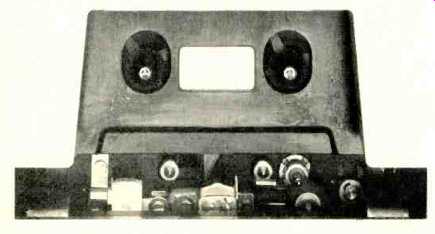
Fig. 1--Close-up view of cassette well.
At the top of the right side of the panel are the peak-reading level meters, with a wide range from -40 to +7 VU. The range around 0 VU is expanded with red markings above zero, the scales are very legible, even at a distance, and the meters are well illuminated; all help to make an excellent display. Below the meters is a row of button switches: EX or SX tape types, 70 or 120 microseconds equalization, 400-Hz tone on-off, multiplex filter in-out, Dolby in-out, IM suppressor in-out, and power on-off. The 70-microsecond equalization is used with the newly introduced SX tape which offers a number of advantages over CrO2 tape, which would use the same equalization. Below the button switches are adjustments for both EX and SX tapes for Bias, Level and IM Suppression. There are pots for each channel with removable caps covering the access holes. Adjustments of Level are made in conjunction with the 400-Hz tone to en sure having the proper Dolby record level. There are individual record level controls for each channel in addition to the very handy master pot. A single control governs the outputs from the two channels. Handles at each end of the panel facilitate moving the unit, which can be easily installed in a cut-out.
On the back are the line-level input and output connections through phono jacks or a DIN socket. Above the jacks is a block schematic of some detail showing the recorder circuitry. In line with its intended use with other equipment, there are no mike level inputs and no head phone jack. The bottom, sides, and back consist of a one piece molded plastic enclosure held in place with five screws. One PCB contains the majority of the circuitry, with five smaller PCBs for such functions as power supply and motor governor. Soldering on the circuits cards was excellent, and the card-to-card wiring was neat and tied. The recorder can be turned on in Play or Record mode with an external timer.
Circuit Description
Of particular interest in the Nakamichi 600 collection of good design features is the unique Intermodulation Suppressor. In other designs, limiters and pre-distorters have been used to limit distortion generated in the recording process. The Nakamichi circuit is immediately different and fascinating because it operates on the playback signal, taking out the distortion that was previously recorded, even on another recorder, but the other recorder must have linear phase characteristics. The approach is based upon some of the characteristics of the magnetic recording process. In most cases, the predominant harmonic distortion component is the third at all frequencies and all levels. Also, the level of the third harmonic changes at a constant rate relative to changes in the record level. Finally, major components of intermodulation distortion change at this same rate with level changes. With careful design, then, a linearizer, or distortion suppressor, could be made to operate on the playback signal, making it more linear and reducing the distortion.
The IM suppressor is part of the sophisticated playback circuitry. EQ, provides the initial high frequency time constant of 70 microseconds and a low-frequency time constant of 120 milliseconds tor proper integration of the lowest frequencies. EQg is an LCR network designed to compensate for head gap and spacing losses. EQ2 has a 22-microsecond time constant which brings the saturation points at the different frequencies to approximately the same level. Typically, there are considerable phase shifts in the playback, with harmonics losing their time relationships to the fundamentals. Without the correction of these shifts, the suppressor could possibly introduce more distortion than it would remove. The phase shifter, therefore, is an essential element in the overall design. Performance tests showed the effectiveness of the suppressor of benefit over a wide range of levels and frequencies. Following the suppressor itself is EQT which provides switching to 120 microseconds as needed. EQ1 undoes the 22 microsecond TC of EQ2, and EQ1 provides the standard 3180 microsecond low-frequency TC.

Fig. 2--Block diagram of playback circuit.
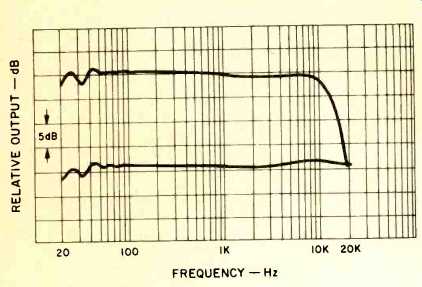
Fig.
3--Record-replay response of Nakamichi 600 using the firm's SX tape without
Dolby. Response with Dolby was virtually identical.
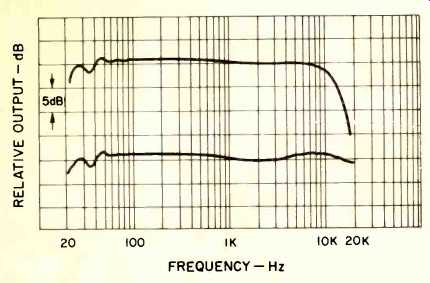
Fig. 4--Record-replay response using Nakamichi EX II tape with Dolby. Response
without Dolby was virtually identical.
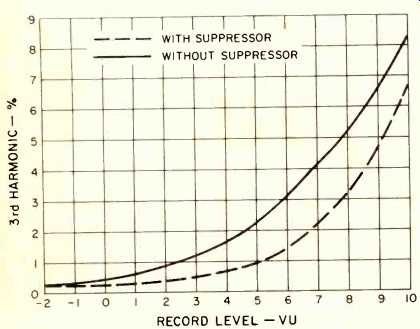
Fig. 5--Percentage of third harmonic versus record level, showing action
of suppressor, using SX tape.
Performance
The Nakamichi 600 provides an outstanding level of performance in a number of areas. The manufacturer states that the focused-field crystal permalloy head is the major reason for the wide frequency response and great dynamic range.
The playback response was flat over most of the range for both equalizations with a gently rising response at the highest frequencies. The unit surpassed the specified 40 Hz to 18 kHz record/playback response at -20 VU quite handily.
With SX tape without Dolby, there was a little droop at 2 kHz and some rise at 8 kHz, but the low-frequency end-point remained the same, and the high end changed slightly to 20.0 kHz. Superior headroom properties at 0 VU record level were shown with the 3-dB down point at 12.0 kHz, 11.0 kHz with Dolby. The results with EXII tape were similarly excellent: from 21 Hz to 20.5 kHz at -20 VU, and 21 Hz to 20.3 kHz with Dolby. At 0 VU the -3 dB point was at 12.0 kHz, 11.8 kHz with Dolby. There was no measureable effect on any of these responses with the suppressor switched in. The record/playback responses discussed here were notable in other respects. The two channels were very well matched, within a fraction of a dB, over the entire frequency range both normal and with Dolby. Accurate Dolby tracking and channel matching are essential to realize the full potential of this noise reduction system. In this regard, the Nakamichi 600 is without doubt the best cassette recorder this reviewer has evaluated. An additional benefit from such performance is that stereo imaging has more solidity and does not shift with level changes.
Measurements were made of the relative levels of the 3rd harmonic of a 1-kHz tone recorded at levels from -10 to +10 VU. A spectrum analyzer was essential in getting re liable data at the lower levels and also permitted observation of other harmonics. This was particularly important in assessing the performance of the IM suppressor. The results for one channel were substantially identical to the other.
With SX tape, the distortion was just 0.56 percent at 0 VU, 0.40 percent with the suppressor. At +7 VU, the distortion was 4.5 percent, 2.5 percent with the suppressor. The benefits of this circuit were in evidence even at -10 VU where it reduced the third harmonic from 0.06 to 0.05 percent. Other harmonics than third appeared at the highest levels, but they were acceptably low even at +10 VU. With Dolby, all distortion figures were about 20 percent lower.
With EXII tape, there was little effect from the suppressor at lower levels, but distortion was a most respectable 0.45 percent at 0 VU, 0.36 with Dolby. At +7 VU, the suppressor reduced the distortion from 3.2 to 1.8 percent, and from 2.8 to 1.4 percent with Dolby. Few harmonics other than third were observed even at +7 to +10 VU. Tests of IM distortion with various combinations of tones revealed that the suppressor obtained reductions of 50 percent at higher record levels. The device also restored the output as a linear function of the input up to +7 VU within a fraction of a dB. Tests were made of the harmonic distortion from 30 Hz to 10 kHz, both at 0 VU and at -20 VU. There is little significance to 3rd harmonic distortion figures for 10 kHz. The distortion values were low across the band for SX tape, with reductions obtained with the suppressor. EXII tape generally had lower distortion at 0 VU than SX tape, but showed little benefit from the suppressor at this level. Distortion figures for -20 VU for both tapes were usually below the limits of the test equipment. Distortion figures for the two channels were substantially identical over the entire band. Suppressor action was primarily on 3rd harmonic at each test frequency up to the highest without adding other harmonics, indicative of excellent phase compensation. In summary, the suppressor was consistently effective in reducing IM and 3rd harmonic distortion without negative side effects.
The signal-to-noise ratio was 61 dBA (A weighting) with SX tape and Dolby, 69 dBA with the suppressor. The ratio for EXII tape was 57.8 dBA with Dolby, 66 dBA with suppressor added. All of these figures are referenced to the 3-percent harmonic distortion level. Separation from one track to the other was a good 46 dB at 1 kHz and 0 VU. Crosstalk to the adjacent track of opposite play direction and erasure were both excellent, over 80 dB down. Line input sensitivity was 66 mV, slightly greater than the specified 60 mV. All pots were smooth in action with very close tracking of the sections of the dual pots. The output level for 0 VU record was 580 mV, exactly as specified. With the multiplex filter in the response was down 3 dB at 16.2 kHz and 32 dB at 19 kHz. The meters are stated to be peak-level type and respond to with in 3 dB with a 33 millisecond burst of 1 kHz at reference level. Response was to the same level with single-cycle bursts every 35 milliseconds. The meters, therefore, do provide peak-level indications with typical speech and music inputs, although they do not respond fully to short, isolated bursts. The slower decay rate facilitated reading and setting levels. Scale markings were found to be quite accurate, and tracking between meters was excellent.
The lowest measured flutter was 0.04% DIN weighted peak, with an average of 0.08%. The tape play speed was 0.9%fast at the standard test 120 V a.c., with very little change from 110 to 130 volts. Rewind time was about 110 seconds, rather slow, but of minor significance. It is quite possible that Nakamichi chose a slower wind to minimize any possible damage to the tape which could affect contact to the heads. The recorder had shown superior amplitude smoothness in the swept-frequency responses, an indicator of good tape/head contact.
In-Use Tests
When the opportunity was presented to record the SUN-YA (State Univ. of New York at Albany) Woodwind Quintet, the 600 was quickly conveyed to the performance hall, complete with mike and a Shure mixer. As judged earlier, the angle of the front panel made all level control and monitoring most natural. The line outputs were used to feed a small headphone amplifier. For a critical test of the unit's capabilities, the performance was recorded at a high level, with many peaks to +5 VU. Even with this approach, the wide range of the meters to -40 VU was of value. A different tape formulation was used for each composition, with a check and adjustment of Dolby record level with the 400-Hz tone. The calibration was already exactly correct for the SX and EXII tapes; the Maxell UD (EX settings) and the TDK SA (SX settings) required some adjustment.
A piece by Milhaud was performed first by the SUNYA quintet and provided challenges for the musicians. The listening experience was a joy, however, with an unstrained openness reserved for some original recordings. Some brittleness in high-level oboe tones was judged to be the result of slight over-blowing, but switching on the distortion suppressor provided instant sweetening. Kvintet by Nielsen demonstrated the subtle impact of the suppressor. Although there was no obvious change, the playback seemed "more musical" with it in. The beneficial action of the suppressor was more apparent on peaks over +7 VU during an encore piece by Ibert.
Insertion and removal of cassettes was easy and fast, yet gentle at the same time. Cleaning and demagnetization was the easiest of any cassette machine checked to date. The instruction book is succinct and clear with helpful route maps drawn over front-panel layouts showing the order of switching or adjustment for various tasks. Nakamichi provides a limited list of recommended tapes including their own SX, EX, and EXII, a necessary step to ensure that all of unit's performance capabilities will be obtained by the user. The directions given on making the adjustments include worth while cautions to prevent uninformed diddling. No detailed schematic is provided, but with the adjustments made avail able, there would be little need for it by most users. The external-timer control function demonstrated good design technique, having a few seconds delay after power turn-on, thus allowing recording to start after transients had died away. A dust cover is supplied which fits neatly over the front panel. All in all, the Nakamichi 600 should be judged a medium- to high-priced recorder with outstanding performance coupled with important and useful features.
-Howard A. Roberson
(Source: Audio magazine, Sept. 1976 )
Also see:
Nakamichi Model 730 Stereo FM Receiver (Dec. 1978)
Nakamichi Model T-100 Audio Analyzer (Nov. 1978)
Nakamichi cassette decks (Dec. 1982)
Nakamichi Tri-Tracer 1000 Cassette Recorder (Mar. 1974)
= = = =